As the hordes head off to climb Kilimanjaro, their eyes firmly set on the summit, there is another place in East Africa, largely ignored. Climbing Mt. Kenya.
Table of contents
Hiking Mt Kenya Trip Report
Standing at 17,057ft (5,199m) above sea-level, Mt. Kenya is Africa’s second highest peak. Located just south of the Equator, 150km from Kenya’s capital Nairobi.
Mt Kenya is a stratovolcano, formed around 3 million years ago. Thought to have once towered over the African plains at 23,000ft with a permanent ice cap, today the remnants of the volcanic plugs form it’s three main peaks.

Three peaks make up Mt Kenya: Batian (5199m/17,057ft), Nelion (5188m/17,021ft) and Lenana (4985m/16,355ft).
Batian and Nelion are technical climbing peaks, suitable for experienced alpine climbers. Point Lenana is a trekking peak.
Not being as famous as Mt Kilimanjaro, nor having the kudos of being “Africa”s highest mountain, and one of the Seven Summits; Mt. Kenya is where you go to get the real “off the beaten track” mountain experience.

Most of us won’t make it up the highest peak, unless experienced in alpine climbing. Hiking Mt Kenya’s slopes – whether or not you decide to go all the way to Point Lenana is a spectacular “altitude trek”.
Forgetting, for the time being, about “summit bagging”, Mt Kenya provides some of the most beautiful hiking trails.
It’s forested slopes provide home to a plethora of wildlife, the lakes are full of rainbow and brown trout; and the valleys and craggy peaks, hewn from the landscape by fire and ice make for a spectacular mountain backdrop.

Hiking through the alpine meadows, through the unique equatorial high-altitude vegetation, sunbirds, hyrax and soaring eagles complete the picture.
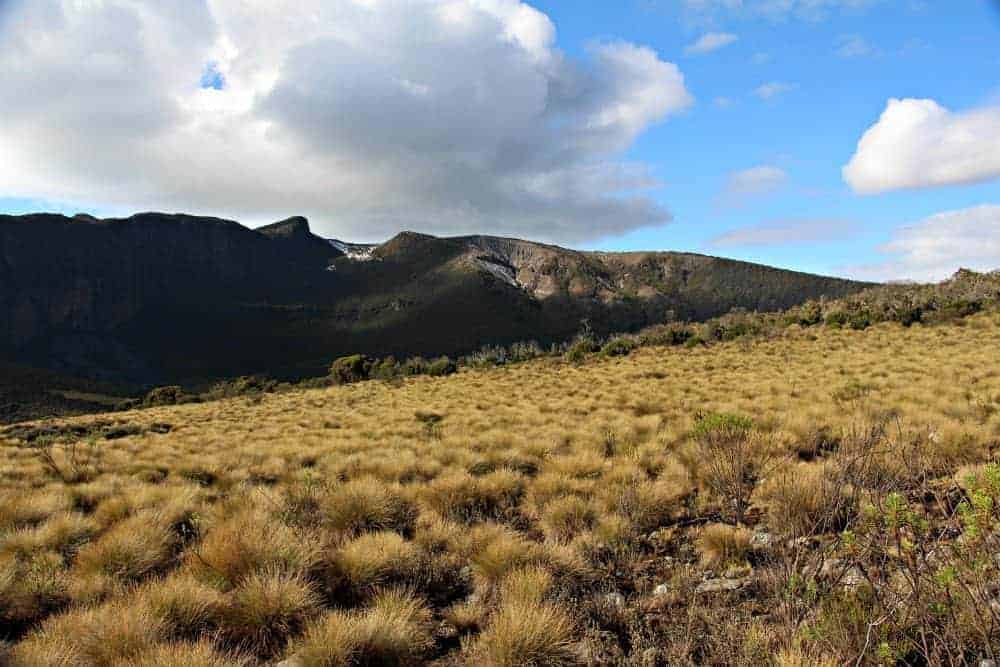
Most folks who go to Kenya do so for the abundance of wildlife, sitting in the back of 4WD vehicles trying to spot the elusive big 5. But to see some of the country on foot is even better.
As I’m not always able to convince my hiking partners to go to such heady heights as the summit (maybe I need new hiking partners?) we took a trip to Mt Kenya to do some high-altitude hiking on her slopes and some fly-fishing in the hopes of a good dinner.
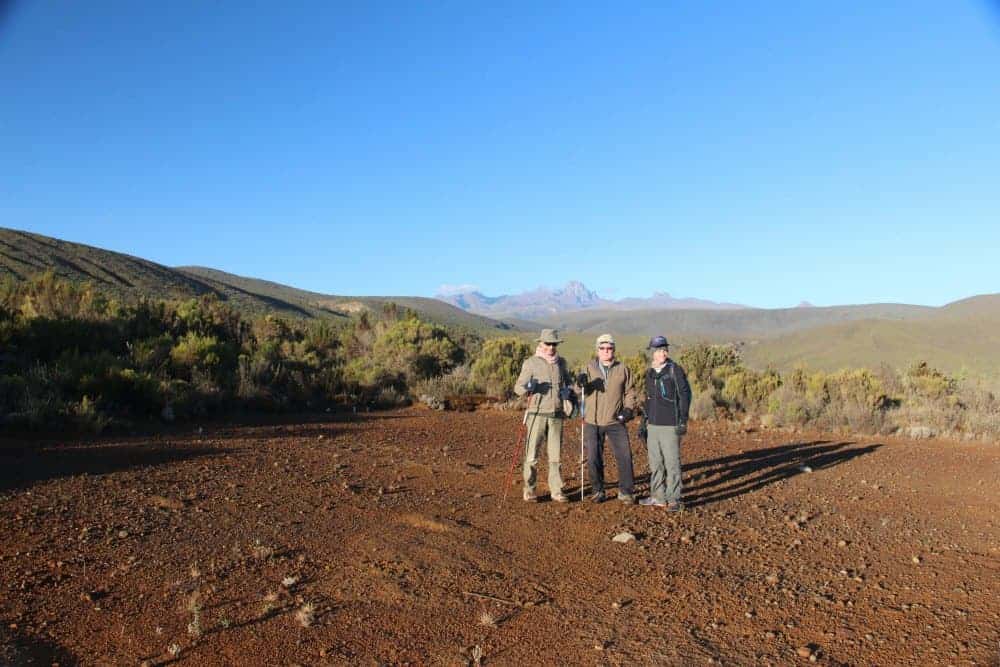
Rutundu Huts
We began hiking Mt Kenya at the now-famous Rutundu Huts, where Prince William allegedly proposed marriage to Catherine. These rustic, wooden huts with no electricity are at 10,200ft next to Lake Rutundu.
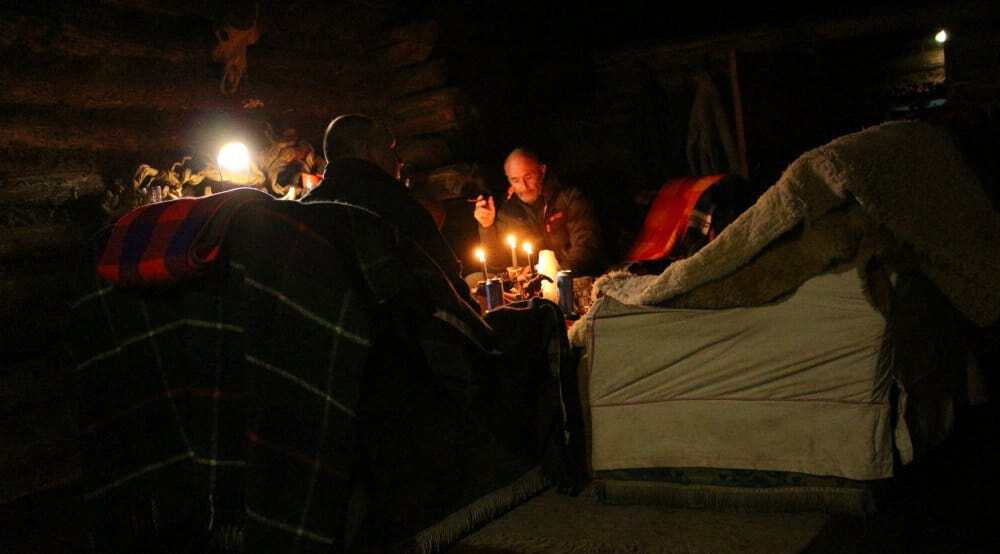
A roaring fire keeps the chills at bay and many tall-stories were told by candlelight.
We hiked up to Lake Alice, named after the Duchess of Gloucester, who visited Kenya shortly after the lake was discovered.
It’s a tough 2-3 hour hike up to 11,000ft. But, oh those views! The high-altitude vegetation is unique: giant lobelias and giant groundsels rise out of the tussocky grasses.

Lake Alice

Some of us cast a fly or two…

The clouds rolling around Lake Alice signal that it’s time to get back to the relative comforts of Rutundu and cook that catch!
After a tough day on the mountain, we cooked the splendid trout and washed it down with some wine before snuggling down in our sleeping bags for a well-deserved night’s rest.
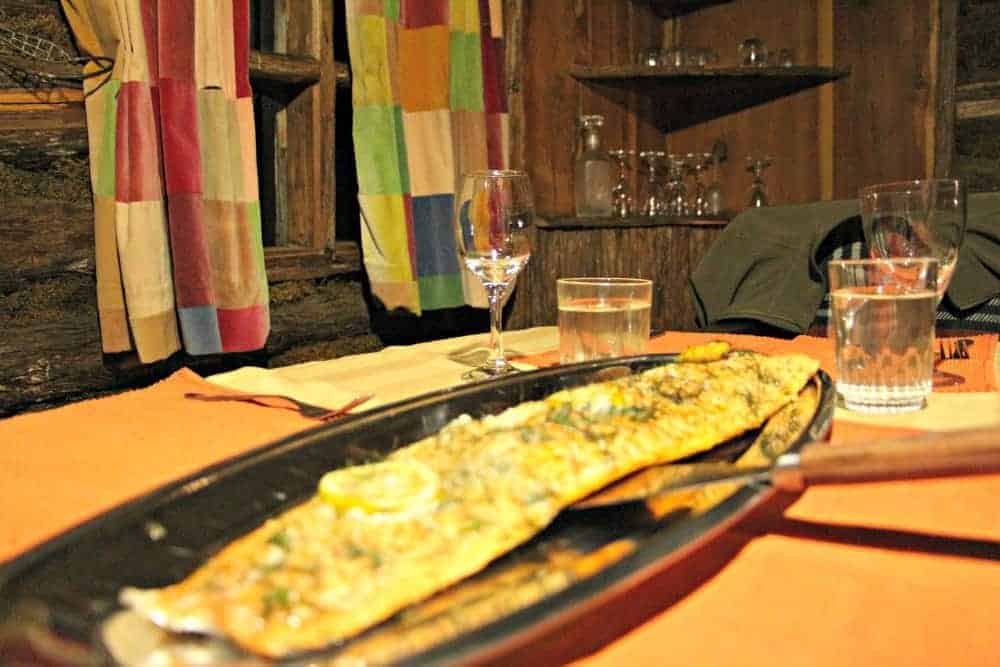
Ragati River
The following day we hiked through the forest to camp by the Ragati River, on the other side of the mountain.
From the alpine vegetation to the lush forest glades where the pristine waters of the Ragati River flows.
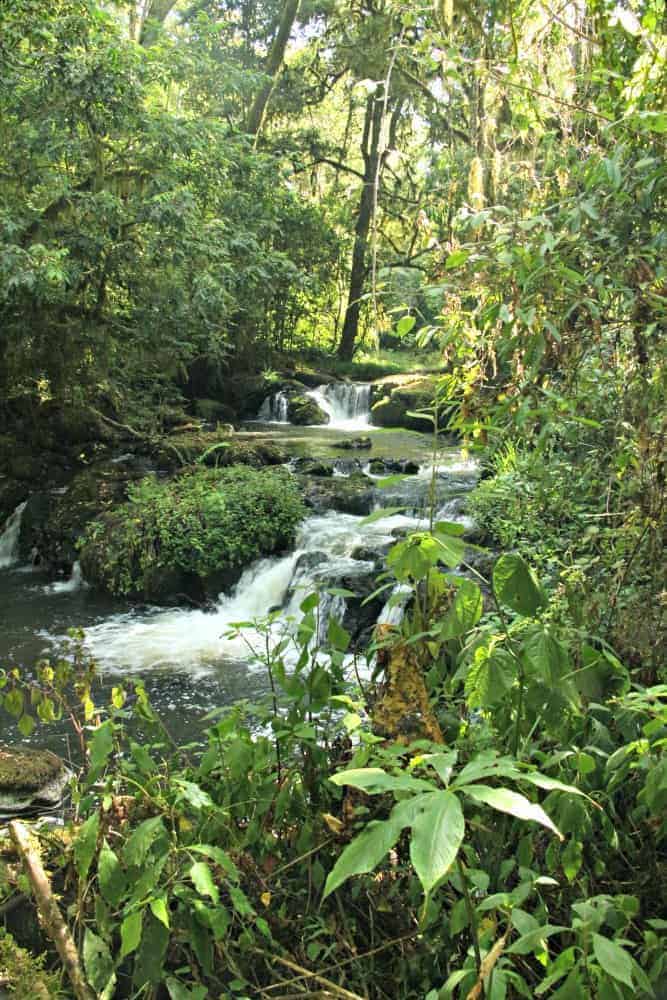
Mid-afternoon, we arrived at our camp site.

Well-appointed tents nestled in the trees. A “mess tent” provided a dining room for our dinner cooked on an open fire. Monkeys in the trees and the sound of birdsong woke us the next morning for our return to civilization.
It’s good to be reminded that hiking in the mountains is not all about summits.

You might also like:
Climbing Mt Kenya: A Quick Look
Where?
Mt Kenya National Park is in central Kenya, just south of the Equator, about 150 kilometers north of Nairobi, Kenya’s capital. It is easily accessible either by plane to the nearby town of Nanyuki or by road.
How?
Whilst it is possible for you and a friend to show up at the gate, pay your park fees and set off on your own, this is not really recommended.
The routes up Mt Kenya are not well-signposted and you’d be carrying a lot of kit. Some intrepid travelers will hire a guide, cook and porter from the nearby town of Nanyuki and hit the trail.
High altitude trekking carries with it a degree of risk. For this reason, many people like to book a tour in advance with a reputable firm.
See our How to Choose a Tour Operator article – the same questions apply to climbing Mt Kenya, even though Point Lenana is 16,355ft as opposed to Kilimanjaro’s 19,340ft.
Many of the accommodation options in the area can arrange a day or overnight hikes on the lower slopes of the mountain.’
When to Climb Mt.Kenya?
Even though it is on the Equator, do not be fooled that you will be in tropical sunshine for your climb. Since the weather at altitude is very unpredictable; rain, hail and snow can easily descend on you without warning.

It’s best to avoid the two rainy seasons (unless you enjoy being a soggy mess) which are:
- Late March to mid-May
- Late October to mid-December
Though it should be noted that weather patterns can be unpredictable in Africa with droughts and failed rains.
Routes Up Mt. Kenya
If you are hiking Mt Kenya with an organized tour operator, there will normally be a choice of routes to point Lenana. Here’s a brief overview of the most common routes:
Chogoria
Arguably the most spectacular route on Mt Kenya, you will take in the vertical cliffs of the Gorges Valley, and the high altitude tarns of Lake Elice and Lake Michaelson.
Enjoying the unique mountain habitat, this route gives the opportunity to sleep high up on the mountain at Austrian Hut, by the Lewis Glacier.
Naro Moru
The fastest route when climbing Mt. Kenya mountain, is really only suitable for those on a tight schedule and wanting to “bag” the Lenana summit.
Being a more rapid ascent means that there is little time for acclimatization (unless you factor in an “acclimatization day”: at which point you might as well use one of the more scenic routes).
In wet weather, this route can be pretty miserable, taking in the infamous “Vertical Bog” which is a steep and muddy quagmire. Descent via this route is fine, so long as you don’t mind muddy boots.
Timau
This little-used route provides the best chance for seeing some of Mt Kenya’s wildlife.
Elephant, eland, Zebra are some of the species you may encounter as you set off on this route.
If it’s solitude and peace you are after on the mountain, then this route is well worth a look. A gradual ascent means you’ll have ample time to acclimatize on a 5 day hike.
Sirimon
This northern route is situated on the drier side of the mountain and although the distance covered is a little farther than the other routes, the gradual ascent allows plenty of time for acclimatization.
Much more scenic than Naro Moru, Sirimon route offers fantastic trekking through the forest to a wide ridge approach to the summit.’
Accommodation is usually in huts, although depending on your operator, you may be able to camp.
What to Pack
Assuming you are not hiking Mount Kenya on your own, if you are planning to go with a tour operator then they will mostly be taking care of your camping equipment.
What you’ll need to bring with you is your clothes and your sleeping bag (and possibly a sleeping mat)
Here’s a quick checklist for what you’ll need for climbing Mt Kenya (I’m assuming you’re not climbing either of the technical peaks):
- Hiking boots with good ankle support – make sure you’ve broken these in! Blisters are a nightmare when climbing.
- Hiking socks, sock-liners and thermal socks for summit day
- Good size Backpack or Daypack if you have a personal porter
- Waterproof stuff-sacks to keep your gear dry in your backpack – at the very least use garbage bags.
- Layers: a good base layer is essential for keeping you dry – no cotton!
- Breathable t-shirts (not cotton) for the warmer days
- Warm, fleece insulating layer to go over your base layer
- Softshell jacket (water resistant) for those chilly dry days
- Down jacket – for those freezing cold nights (just don’t get it wet!)
- Hardshell jacket (optional) or another fleece layer combined with your waterproofs
- WATERPROOFS! Both trousers and jacket, keep them handy in your backpack
- Hiking pants – convertibles are best, so you can wear them as shorts on the lower slopes, combine them with a base layer for higher altitudes
- Warm hat or beanie. Personally, I enjoy the balaclava look.
- Good winter sleeping bag rated to 0F for comfort.
- Sleeping bag liner to keep your sleeping bag clean
- Personal medications and toiletries: a Kilimanjaro comprehensive list can be found here (based on a Kilimanjaro climb)
- A good sense of humor and an adventurous spirit.
Have you been to Mt Kenya? Would you like to climb Mount Kenya? Let us know in the comments below
Need More Advice on Gear and Footwear?
Here are some links to our most popular articles:















Great information. Yes, Mt Kenya is like my playing ground. I never get enough of it. As a mountain guide i urge more people to get out of their comfort and either hike or summit. I found the Kibatia springs too. Just about 3 hr hike from Lake Ellis.